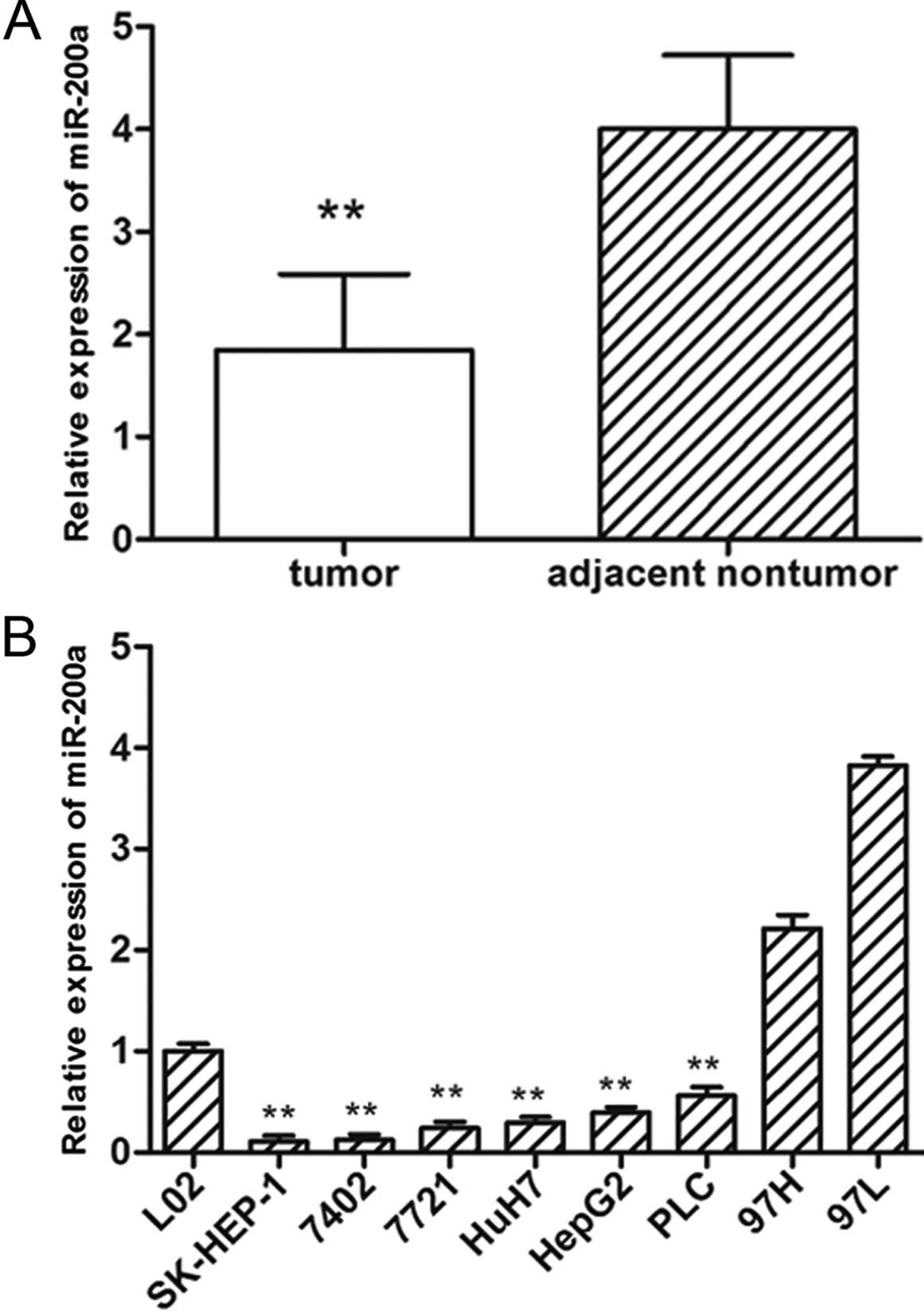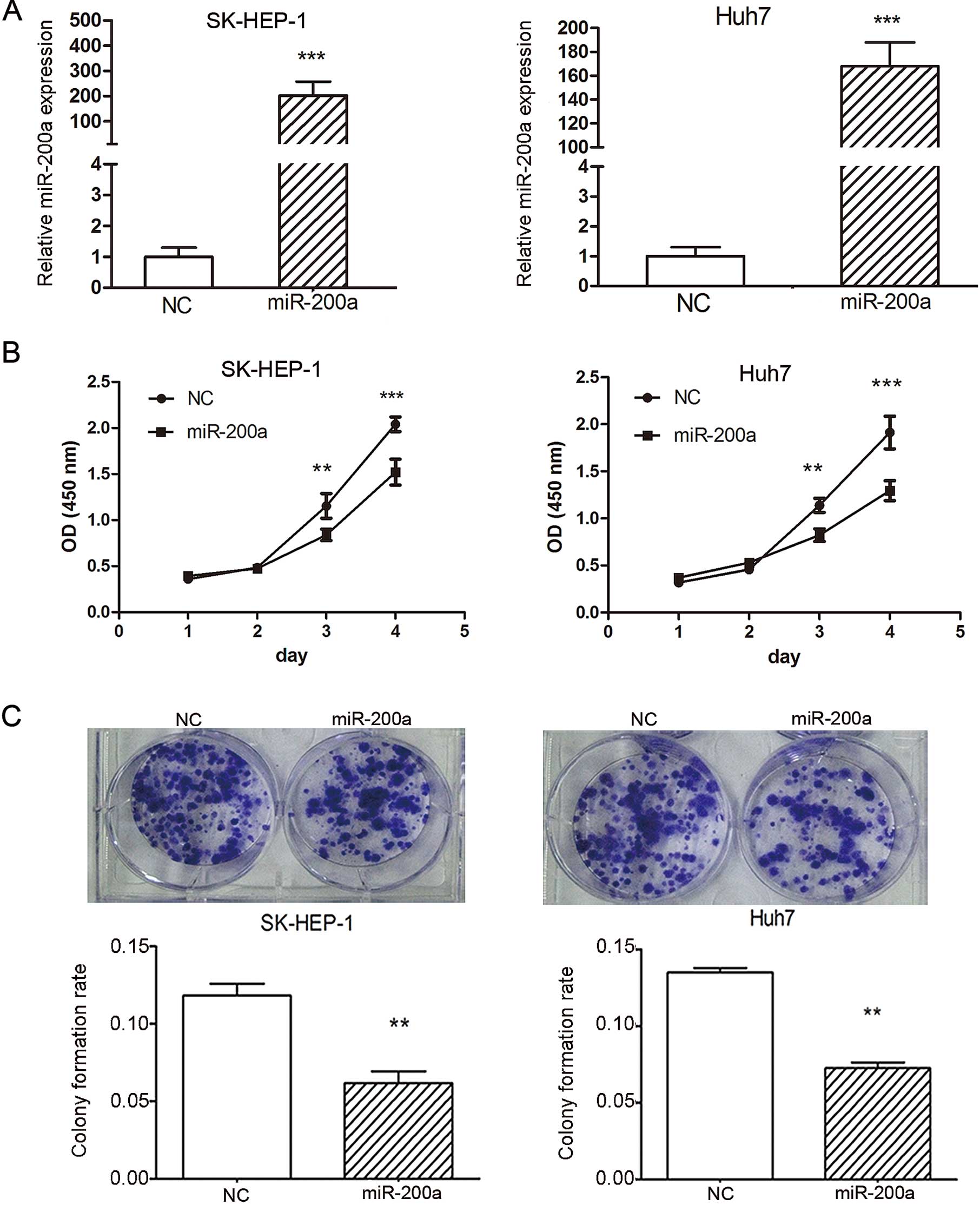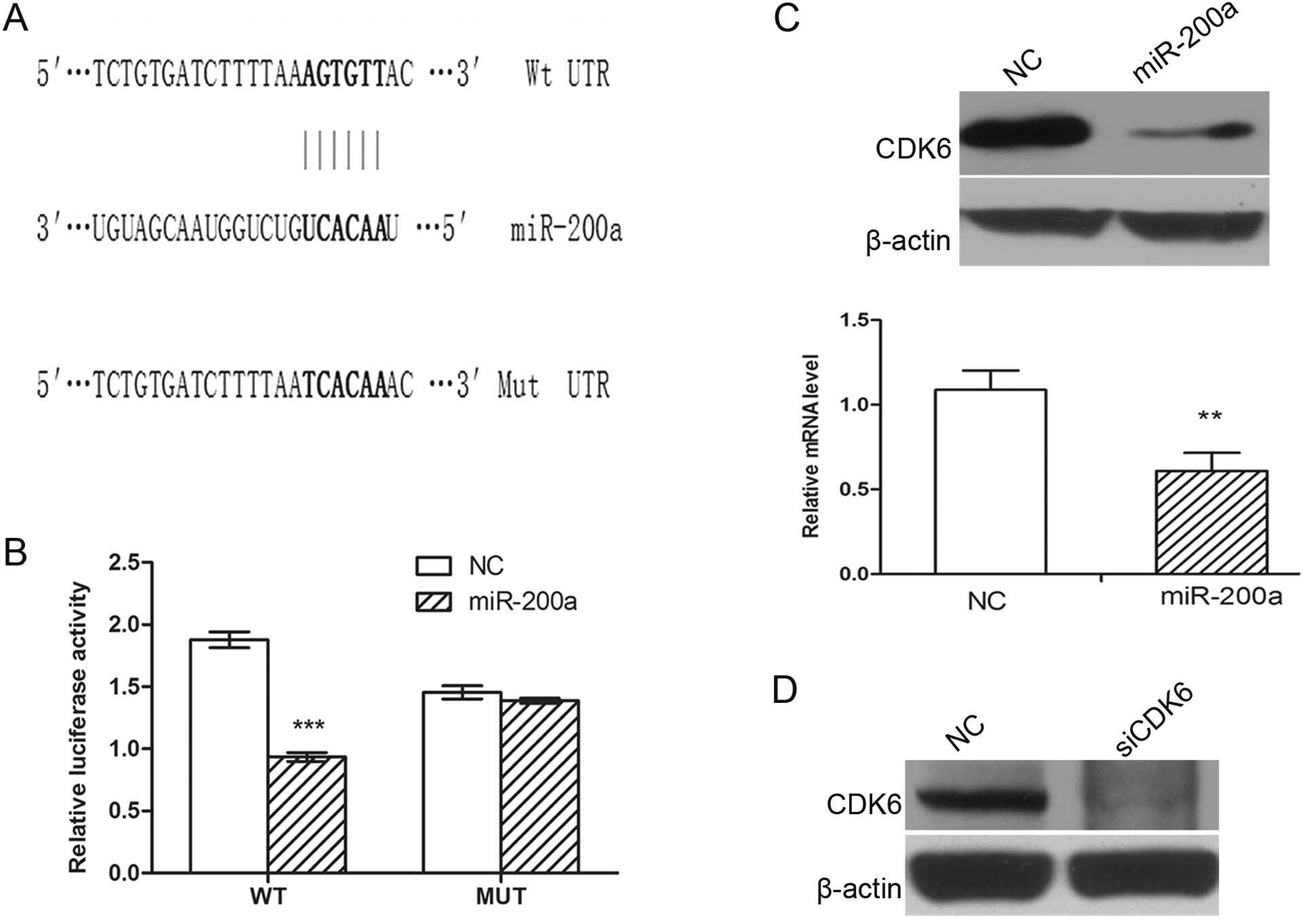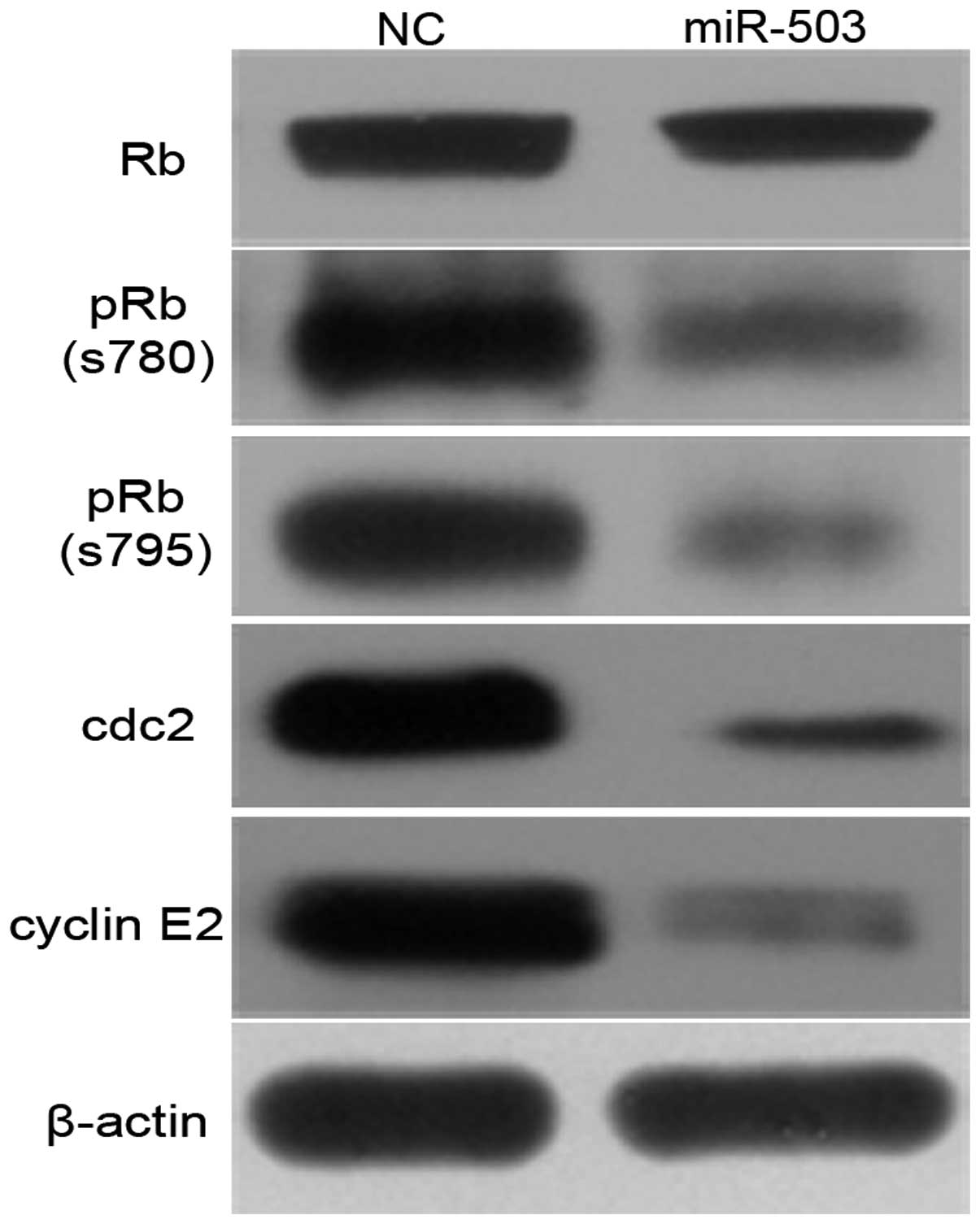microRNA-200a is an independent prognostic factor of hepatocellular carcinoma and induces cell cycle arrest by targeting CDK6
- Authors:
- Published online on: September 4, 2013 https://doi.org/10.3892/or.2013.2715
- Pages: 2203-2210
Abstract
Introduction
Hepatocellular carcinoma (HCC) is one of the most common human malignancies and the leading cause of cancer-related mortality worldwide (1,2). The development and progression of HCC involve the deregulation of genes that are crucial to cell cycle control, cell growth, apoptosis and cell migration. In the past few decades, studies have focused on investigating the protein-coding genes underlying the development and progression of HCC. Recently, reports suggest that misexpression of microRNAs (miRNAs) also contributes to tumorigenesis (3,4).
miRNAs are small, endogenous, non-coding RNAs known to negatively regulate the expression of protein-coding genes (5,6). miRNAs are involved in the regulation of various biological processes, such as development, cell proliferation, apoptosis and differentiation (7–9). Deregulation of miRNAs has been observed in various types of human cancer (10–13). Accumulating evidence indicates that miRNAs may function as oncogenes or tumor suppressor genes (TSGs) during tumor development and progression (4). Using an miRNA microarray, Murakami et al(14) determined that microRNA-200a (miR-200a) was significantly downregulated in HCC tissues when compared with the level in adjacent non-tumor tissues. However, the biological function of miR-200a in HCC and the detailed mechanisms in tumorigenesis are still largely unknown.
In the present study, we confirmed that downregulation of miR-200a occurred frequently in HCC tissues and cell lines. Additionally, miR-200a may be an independent prognostic factor. Moreover, ectopic expression of miR-200a dramatically inhibited cell proliferation and clonogenicity in vitro in HCC cells. Furthermore, gain-of-function studies revealed that miR-200a induced G1 phase arrest of HCC cells. Further study identified CDK6 as a novel functional target of miR-200a. Collectively, these findings indicate that miR-200a functions as a potential tumor suppressor in HCC, providing a potential target for HCC therapy.
Materials and methods
Cell lines and tissue specimens
Immortalized normal liver cells (L02), human HCC cell lines (SK-HEP-1, HepG2, MHCC97H, MHCC97L, PLC, HuH7, SMMC-7721 and Bel-7402) and human embryonic kidney cells (HEK293T) were maintained in the recommended culture condition and incubated at 37ºC in a humidified environment containing 5% CO2. Paired HCC and adjacent non-tumor liver tissues were collected from patients undergoing liver transplantation or partial hepatectomy at The First Affiliated Hospital, School of Medicine, Zhejiang University (Hangzhou, Zhejiang, China). Written informed consent was obtained from each patient. A total of 120 patients had a clear histologic diagnosis of HCC with complete clinicopathological data, and all patients were followed up for survival analysis. None of the patients received radiotherapy or chemotherapy before surgery. All sample data were obtained from clinical and pathologic records and are summarized in Table I.
Oligoribonucleotides
miR-200a mimic and the control RNA duplex (referred to as NC) were used for the transient gain-of-function study. The small interfering RNA (siRNA) targeting the human CDK6 transcript was designated as siCDK6. The NC for both the miRNA mimic and siRNA was non-homologous to any human genome sequence. All the RNA oligoribonucleotides (Table II) were purchased from Genepharma (Shanghai, China). All oligoribonucleotides used in the present study are shown in Table II.
RNA extraction and quantitative reverse transcriptase-polymerase chain reaction (qRT-PCR)
Total RNA from cell lines and clinical samples was isolated using the mirVana miRNA Isolation kit (Ambion). qRT-PCR was performed to detect the expression of miR-200a in various cell lines and clinical samples and the expression of CDK6 at the mRNA level. RNA was reverse transcribed using One Step PrimeScript miRNA cDNA Synthesis kit (Takara, Japan). The cDNA was then quantified by real-time RT-PCR using SYBR Premix Ex Taq (Takara). All PCR reactions were performed using the ABI7500 system (Applied Biosystems, Foster City, CA, USA). U6 or glyceraldehyde 3-phosphate dehydrogenase (GAPDH) was used as an internal control. All primers used are listed in Table II.
Western blotting
Western blotting was performed to detect the gene expression at the protein level. Protein was extracted from transfected SK-HEP-1 cells using modified RIPA buffer in the presence of proteinase inhibitor cocktail. Equivalent quantities (30–50 μg) of protein were separated on 10% SDS-polyacrylamide gels and transferred to polyvinylidene difluoride membranes. Membranes were blocked with 5% non-fat milk and then incubated overnight at 4ºC with the appropriate primary antibody at the dilutions specified by the manufacturer. The membranes were then washed three times in 10 ml TBST and incubated with the corresponding horseradish peroxidase (HRP)-conjugated secondary antibody at a dilution of 1:2,000 for 1 h. The bound secondary antibody was detected using an Enhanced chemiluminescence (ECL) system (Pierce Biotechnology, Inc., Rockford, IL, USA). Primary antibodies were as follows: anti-CDK6, anti-cyclin E2, anti-Rb, anti-phospho-Ser780-Rb, anti-cdc2, (Cell Signaling Technology), anti-phospho-Ser795-Rb and anti-β-actin (Epitomics).
Cell transfection
All transfections were performed using Lipofectamine® 2000 (Invitrogen) according to the manufacturer’s instructions. Briefly, SK-HEP-1, Huh7 or HEK293T cells were transfected with DNA, miRNA mimic, siRNA or NC. All RNA transfections were performed at a final concentration of 50 nM. Cells were collected for assay 48 h after transfection.
Cell proliferation assay
SK-HEP-1 and Huh7 cells seeded at a density of 4,000/well into 96-well plates were transfected with miR-200a mimic or NC. After incubating the cells for the specified time (1, 2, 3 or 4 days), a cell proliferation assay was performed using Cell Counting Kit-8 (CCK-8) (Dojindo) according to the manufacturer’s instructions. The solution absorbance was measured spectrophotometrically at 450 nm with the MRX II absorbance reader (Dynex Technologies, Chantilly, VA, USA). The experiments were performed in triplicate.
Colony formation assay
Aliquots of viable transfected SK-HEP-1 and Huh7 cells (1,000/well) were placed in 6-well plates 24 h after transfection and maintained in complete medium for 2 weeks. Colony formation was evaluated by staining the cells with 0.1% crystal violet. The rate of colony formation was calculated using the following equation: Colony formation rate = (number of colonies/number of seeded cells) × 100%. The experiments were performed in triplicate.
Cell cycle analysis
Forty-eight hours after transfection, SK-HEP-1 and Huh7 cells were harvested, washed with PBS and fixed in 70% ethanol at 4ºC overnight. Staining for DNA content was performed using a DNA Prep Stain (Beckman Coulter, Fullerton, CA, USA). Cell populations in the G0/G1, S and G2/M phases were determined using the BD™ LSRII flow cytometry system with FACSDiva software (both from BD Bioscience, Franklin Lakes, USA). Data were analyzed using ModFit LT software. The experiments were performed in triplicate.
Target prediction
To predict the target genes and the 3′ UTR binding sites bound by the seed region of miR-200a, the TargetScan (15) (http://www.targetscan.org/) and PicTar (16) (http://pictar.mdc-berlin.de/) databases were used. CDK6 was chosen as the target candidate according to both TargetScan and PicTar databases.
Vector construction and luciferase reporter assay
The 3′ UTR of CDK6 was amplified by PCR. The amplified sequence was subcloned and ligated into the pmirGLO Dual-Luciferase miRNA Target Expression Vector (Promega, Madison, WI, USA). The recombinant reporter vector was identified by sequencing and termed the wild-type (Wt). To create the miR-200a binding site mutants, the binding region of the seed sequence (5′-AGTGTT-3′) was mutated to the sequence 5′-TCACAA-3′, using the QuikChange Lightning Site-Directed Mutagenesis kit (Stratagene) according to the manufacturer’s protocol. The recombinant vector was confirmed by sequencing and termed the mutant type (Mut). 293T cells plated in a 24-well plate were co-transfected with 50 nM of either the miR-200a mimic or NC and 100 ng of pmirGLO vector comprising Wt or Mut 3′ UTR of CDK6 using Lipofectamine® 2000. Forty-eight hours after transfection, the relative luciferase activity was measured by the Dual-Luciferase Reporter Assay System (Promega). All transfection experiments were performed in triplicate.
Statistical analysis
Data are presented as the means ± SD. Comparisons were made by using the Student’s t-test, the χ2 test and the log-rank test. Overall survival rates were calculated actuarially according to the Kaplan-Meier method. Variables with a value of P<0.05 in univariate analysis were used in a subsequent multivariate analysis based on the Cox proportional hazards model. A value of P<0.05 was considered to indicate a statistically significant result.
Results
miR-200a is frequently downregulated in HCC cell lines and tissues
To further confirm the expression pattern of miR-200a in HCC, we detected the expression of miR-200a in 120 paired HCC and adjacent non-cancerous liver tissues by real-time qRT-PCR. Compared with the adjacent non-tumor tissues, significant downregulation of miR-200a was observed in the HCC tissues (Fig. 1A). Furthermore, the expression of miR-200a was noticeably reduced in 6 of 8 (75.0%) HCC cell lines examined when compared with the expression in the normal liver cell line (L02) (Fig. 1B). These results suggest that reduced miR-200a expression is a frequent event in human HCC and may be involved in tumorigenesis.
Downregulation of miR-200a is associated with worse prognosis
In the present study, patients with expression values less than the average level of miR-200a in HCC tissues (1.87, normalized to U6) were assigned to the low expression group (n=64) whereas patients with values above the average were assigned to the high expression group (n=56). Our data showed a significant association between miR-200a expression and the AFP level, histologic grade, TNM stage and PVTT (Table I). Furthermore, the Kaplan-Meier method revealed that a lower miR-200a level was associated with shorter overall survival (P<0.01) (Fig. 2). Multivariate analysis further confirmed that a reduced miR-200a level was an independent and significant prognostic factor for survival (HR, 2.621; CI, 1.116–4.642; P=0.004; Table III). Collectively, these data suggest that deregulation of miR-200a may contribute to the development and progression of HCC.
Ectopic expression of miR-200a significantly inhibits cell proliferation
The frequent downregulation of miR-200a in HCC cell lines and tissues suggests that miR-200a may serve as a potential TSG in HCC. To test the potential tumor-suppressor role of miR-200a in HCC, the effect of ectopic miR-200a on cell growth was evaluated using the CCK-8 cell viability assay. The expression of miR-200a was markedly increased in the SK-HEP-1 and Huh7 cells transfected with 50 nM miR-200a mimic when compared with NC, normalized to U6 (Fig. 3A). Our data revealed that miR-200a overexpression significantly inhibited cell proliferation in SK-HEP-1 and Huh7 cells compared to NC. At day 1, the OD values of the miR-200a mimic and NC control cells were not significantly different. However, from day 3 onwards, the OD values of the miR-200a-treated SK-HEP-1 and Huh7 cells were significantly lower than the value of the control cells (Fig. 3B). These data indicated that miR-200a inhibited cell proliferation in vitro.
miR-200a suppresses clonogenicity in vitro
To further investigate the potential role of miR-200a in tumorigenesis, a colony formation assay was performed in SK-HEP-1 and Huh7 cells. Cells were transfected with the miR-200a mimic or NC duplex, and then allowed to grow to a very low density. Notably, SK-HEP-1 and Huh7 cells transfected with 50 nM miR-200a mimic displayed much fewer and smaller colonies compared with the NC duplex-transfected cells (Fig. 3C), suggesting a growth-inhibitory role of miR-200a.
Ectopic expression of miR-200a induces cell cycle arrest
To explore the mechanisms underlying the suppression of tumor growth by miR-200a, the effect of miR-200a on cell cycle progression was investigated by flow cytometry. The assay showed that overexpression of miR-200a resulted in an accumulation of a G1 population in the SK-HEP-1 (Fig. 4A) and Huh7 cells (Fig. 4B). These results indicated that miR-200a inhibited HCC cell proliferation by inducing cell cycle arrest at the G1 phase.
CDK6 is a direct functional target of miR-200a
It is generally believed that miRNAs exert their function through negatively regulating the expression of their downstream target genes. To further elucidate the molecular mechanism by which miR-200a inhibits G1/S transition, CDK6 was predicted as a potential target of miR-200a by TargetScan and PicTar. A single putative miR-200a-binding site was mapped in the 3′ UTR of CDK6 (Fig. 5A). To validate whether CDK6 is a direct target of miR-200a, a human CDK6 3′ UTR fragment containing Wt or the mutant (Mut) miR-200a binding sequence (Fig. 5A) was cloned downstream of the firefly luciferase reporter gene in pmirGLO. In HEK293 cells cotransfected with the reporter plasmids and the miR-200a mimic or NC duplex, the luciferase activity of the reporter that contained Wt 3′ UTR was significantly suppressed by miR-200a mimic, but the luciferase activity of the mutant reporter was unaffected (Fig. 5B), indicating that miR-200a may suppress gene expression through miR-200a binding sequence at the 3′ UTR of CDK6. Additionally, transfection of the miR-200a mimic decreased CDK6 expression in SK-HEP-1 cells at both the protein and mRNA levels (Fig. 5C), suggesting that CDK6 expression is inhibited by miR-200a at the post-transcriptional level. Collectively, the results showed that miR-200a regulated the expression of endogenous CDK6 by directly targeting the 3′ UTR of CDK6 mRNA and that CDK6 is a novel target of miR-200a.
miR-200a is involved in G1/S transition through the downregulation of CDK6
To explore the role of CDK6 in the miR-200a-regulated G1/S transition, we investigated whether knockdown of CDK6 may phenocopy the effect of miR-200a overexpression. SK-HEP-1 cells were transfected with siRNA duplex targeting CDK6, which resulted in a significant reduction in the protein levels (Fig. 5D). The silencing of CDK6 led to G1-phase arrest (Fig. 4C), phenocopying the outcome of miR-200a overexpression.
CDK6 is one of the crucial molecules that initiate the phosphorylation of retinoblastoma (Rb), which results in the release of E2F and subsequently the transactivation of genes required for S-phase entry. Therefore, we investigated whether miR-200a could attenuate these events. Ectopic expression of miR-200a caused a reduction in phosphorylated Rb protein, however little effect on the total Rb protein was noted (Fig. 6). Moreover, the effect of miR-200a on endogenous genes such as cdc2 and cyclin E2, downstream genes of E2F3, was further investigated. Overexpression of miR-200a induced significant downregulation of cdc2 and cyclin E2 in SK-HEP-1 cells (Fig. 6).
These data indicate that miR-200a may induce cell cycle arrest at G1 phase by directly inhibiting CDK6 through the Rb-E2F signaling pathway.
Discussion
Although deregulation of miRNAs has been observed in various types of cancers (11,17), the molecular mechanisms by which miRNAs regulate the process of carcinogenesis and the biological behavior of cancer cells are still largely unknown. Growing evidence has revealed that a defect in cell cycle control is an essential step during carcinogenesis (18,19). miR-138 was found to induce cell cycle arrest by targeting cyclin D3 in HCC (20). miR-195 suppressed G1/S transition of human HCC cells by targeting cyclin D1, CDK6 and E2F3 (21). Therefore, misexpression of cell cycle-related miRNAs may facilitate tumorigenesis. A previous miRNA microarray revealed that miR-200a was significantly downregulated in HCC (14). Recently altered expression of miR-200a has been observed in different types of diseases, including cancers. Downregulation of the miR-200 family expression was recently shown to be associated with tumor progression (22). Epithelial-to-mesenchymal transition (EMT), a crucial process in the transformation of tumor cells into aggressive metastatic cancer cells, also seems to be tightly regulated by this family (23,24). Saydam et al(25) reported that downregulation of miR-200a in brain tumors promoted tumor growth by upregulating cyclin D1 and β-catenin in vitro and in vivo. Similarly, it was reported that the overexpression of miR-200a inhibited nasopharyngeal carcinoma cell growth, migration and invasion by downregulation of β-catenin and Smad interacting protein 1 (26).
Little is known concerning the role of the miR-200 family in cell growth and proliferation in HCC. Hung et al(27) found that members of the miR-200 family (miR-200a and miR-200b) were involved in HCC migration by regulating E-cadherin expression. However, the role of miR-200 family members and the relative molecular mechanism in HCC remain largely unclear. In the present study, we attempted to elucidate the role of miR-200a in HCC. Our findings revealed that miR-200a was frequently downregulated in human HCC tissues. Lee et al(28) previously reported that the miR-200 family, including miR-200a, was upregulated in endometrial endometrioid carcinomas when compared with expression in normal endometrial tissues. This discrepancy may be due to the use of different cell lines. In the present study, multivariate analysis revealed that miR-200a is an independent prognostic factor for survival. In addition, gain-of-function studies indicated that overexpression of miR-200a suppressed cell proliferation by induction of cell cycle arrest in HCC cell lines. Moreover, we identified CDK6 as a direct target of miR-200a in HCC, which may provide new insights into the mechanisms underlying tumorigenesis. These results imply the important role of miR-200a in the tumorigenesis of HCC.
The family of CDKs and their activating partners (cyclins) are crucial molecules involved in cell cycle control. The G1/S transition is regulated primarily by D-type cyclins in complex with CDK4/CDK6 and E-type cyclins in complex with CDK2. These complexes cooperate in phosphorylating and preventing Rb binding to E2F, thus activating E2F-mediated transcription and driving cells from G1 into S phase (29). However, the detailed mechanisms of cell cycle regulation in HCC require further investigation. Our results showed that miR-200a induced cell cycle arrest of HCC cells by downregulation of CDK6 at both the mRNA and protein levels. Further investigation revealed that ectopic miR-200a expression significantly inhibited Rb phosphorylation and the expression level of cdc2 and cyclin E2 at the protein level (Fig. 6). Collectively our results indicate that miR-200a may be involved in the induction of cell cycle arrest in HCC through the CDK/Rb/E2F pathway.
The underlying mechanism responsible for the decreased expression of miR-200a in HCC remains unknown. miR-200a is located on chromosome 1p36, a region which is often deleted in several types of cancer (30,31), providing a plausible mechanism for the reduced miR-200a expression in HCC. In addition, promoter hypermethylation or transcriptional regulation may account at least in part for the reduced miR-200a expression in HCC. Further investigation is required to verify this hypothesis.
In summary, we confirmed the frequent downregulation of miR-200a in HCC and revealed the potential role of miR-200a in tumorigenesis. Our data indicate that miR-200a may function as a potential tumor suppressor and could be an independent prognostic marker in HCC patients. Therefore, miR-200a may serve as a useful therapeutic target for HCC therapy.
Acknowledgements
We thank Jilei Fu for the collection of clinical data and Rong Su for her excellent technical assistance. The present study was supported by the following grants and foundations: National S&T Major Project (2012zx10002-017); NSFC for Innovative Research Group (81121002); the National Natural Science Foundation of China (81201944); Zhejiang Provincial Natural Science Foundation of China for Distinguished Young Scholars (no. R2110125).
References
|
Parkin DM, Bray F, Ferlay J and Pisani P: Global cancer statistics, 2002. CA Cancer J Clin. 55:74–108. 2005. View Article : Google Scholar | |
|
Aravalli RN, Steer CJ and Cressman EN: Molecular mechanisms of hepatocellular carcinoma. Hepatology. 48:2047–2063. 2008. View Article : Google Scholar | |
|
Calin GA and Croce CM: MicroRNA signatures in human cancers. Nat Rev Cancer. 6:857–866. 2006. View Article : Google Scholar : PubMed/NCBI | |
|
Esquela-Kerscher A and Slack FJ: Oncomirs - microRNAs with a role in cancer. Nat Rev Cancer. 6:259–269. 2006. View Article : Google Scholar | |
|
Ambros V: The functions of animal microRNAs. Nature. 431:350–355. 2004. View Article : Google Scholar : PubMed/NCBI | |
|
Bartel DP: MicroRNAs: genomics, biogenesis, mechanism, and function. Cell. 116:281–297. 2004. View Article : Google Scholar : PubMed/NCBI | |
|
Schratt GM, Tuebing F, Nigh EA, et al: A brain-specific microRNA regulates dendritic spine development. Nature. 439:283–289. 2006. View Article : Google Scholar : PubMed/NCBI | |
|
Brennecke J, Hipfner DR, Stark A, Russell RB and Cohen SM: bantam encodes a developmentally regulated microRNA that controls cell proliferation and regulates the proapoptotic gene hid in Drosophila. Cell. 113:25–36. 2003. View Article : Google Scholar : PubMed/NCBI | |
|
Bartel DP: MicroRNAs: target recognition and regulatory functions. Cell. 136:215–233. 2009. View Article : Google Scholar : PubMed/NCBI | |
|
Su H, Yang JR, Xu T, et al: MicroRNA-101, down-regulated in hepatocellular carcinoma, promotes apoptosis and suppresses tumorigenicity. Cancer Res. 69:1135–1142. 2009. View Article : Google Scholar : PubMed/NCBI | |
|
Lu J, Getz G, Miska EA, et al: MicroRNA expression profiles classify human cancers. Nature. 435:834–838. 2005. View Article : Google Scholar : PubMed/NCBI | |
|
Yanaihara N, Caplen N, Bowman E, et al: Unique microRNA molecular profiles in lung cancer diagnosis and prognosis. Cancer Cell. 9:189–198. 2006. View Article : Google Scholar : PubMed/NCBI | |
|
Iorio MV, Visone R, Di Leva G, et al: MicroRNA signatures in human ovarian cancer. Cancer Res. 67:8699–8707. 2007. View Article : Google Scholar : PubMed/NCBI | |
|
Murakami Y, Yasuda T, Saigo K, et al: Comprehensive analysis of microRNA expression patterns in hepatocellular carcinoma and non-tumorous tissues. Oncogene. 25:2537–2545. 2006. View Article : Google Scholar : PubMed/NCBI | |
|
Lewis BP, Burge CB and Bartel DP: Conserved seed pairing, often flanked by adenosines, indicates that thousands of human genes are microRNA targets. Cell. 120:15–20. 2005. View Article : Google Scholar : PubMed/NCBI | |
|
Krek A, Grün D, Poy MN, et al: Combinatorial microRNA target predictions. Nat Genet. 37:495–500. 2005. View Article : Google Scholar | |
|
Volinia S, Calin GA, Liu CG, et al: A microRNA expression signature of human solid tumors defines cancer gene targets. Proc Natl Acad Sci USA. 103:2257–2261. 2006. View Article : Google Scholar : PubMed/NCBI | |
|
Massagué J: G1 cell-cycle control and cancer. Nature. 432:298–306. 2004. | |
|
Deshpande A, Sicinski P and Hinds PW: Cyclins and cdks in development and cancer: a perspective. Oncogene. 24:2909–2915. 2005. View Article : Google Scholar : PubMed/NCBI | |
|
Wang W, Zhao LJ, Tan YX, Ren H and Qi ZT: MiR-138 induces cell cycle arrest by targeting cyclin D3 in hepatocellular carcinoma. Carcinogenesis. 33:1113–1120. 2012. View Article : Google Scholar : PubMed/NCBI | |
|
Xu T, Zhu Y, Xiong Y, Ge YY, Yun JP and Zhuang SM: MicroRNA-195 suppresses tumorigenicity and regulates G1/S transition of human hepatocellular carcinoma cells. Hepatology. 50:113–121. 2009. View Article : Google Scholar : PubMed/NCBI | |
|
Baffa R, Fassan M, Volinia S, et al: MicroRNA expression profiling of human metastatic cancers identifies cancer gene targets. J Pathol. 219:214–221. 2009. View Article : Google Scholar : PubMed/NCBI | |
|
Gregory PA, Bert AG, Paterson EL, et al: The miR-200 family and miR-205 regulate epithelial to mesenchymal transition by targeting ZEB1 and SIP1. Nat Cell Biol. 10:593–601. 2008. View Article : Google Scholar : PubMed/NCBI | |
|
Ahn SM, Cha JY, Kim J, et al: Smad3 regulates E-cadherin via miRNA-200 pathway. Oncogene. 31:3051–3059. 2012. View Article : Google Scholar : PubMed/NCBI | |
|
Saydam O, Shen Y, Würdinger T, et al: Downregulated microRNA-200a in meningiomas promotes tumor growth by reducing E-cadherin and activating the Wnt/beta-catenin signaling pathway. Mol Cell Biol. 29:5923–5940. 2009. View Article : Google Scholar : PubMed/NCBI | |
|
Xia H, Ng SS, Jiang S, et al: miR-200a-mediated downregulation of ZEB2 and CTNNB1 differentially inhibits nasopharyngeal carcinoma cell growth, migration and invasion. Biochem Biophys Res Commun. 391:535–541. 2010. View Article : Google Scholar : PubMed/NCBI | |
|
Hung CS, Liu HH, Liu JJ, et al: MicroRNA-200a and -200b mediated hepatocellular carcinoma cell migration through the epithelial to mesenchymal transition markers. Ann Surg Oncol. Aug 7–2012.(Epub ahead of print). | |
|
Lee JW, Park YA, Choi JJ, et al: The expression of the miRNA-200 family in endometrial endometrioid carcinoma. Gynecol Oncol. 120:56–62. 2011. View Article : Google Scholar : PubMed/NCBI | |
|
Grillo M, Bott MJ, Khandke N, et al: Validation of cyclin D1/CDK4 as an anticancer drug target in MCF-7 breast cancer cells: effect of regulated overexpression of cyclin D1 and siRNA-mediated inhibition of endogenous cyclin D1 and CDK4 expression. Breast Cancer Res Treat. 95:185–194. 2006. View Article : Google Scholar | |
|
Bagchi A and Mills AA: The quest for the 1p36 tumor suppressor. Cancer Res. 68:2551–2556. 2008. View Article : Google Scholar : PubMed/NCBI | |
|
Sato Y, Kobayashi H, Suto Y, et al: Chromosomal instability in chromosome band 12p13: multiple breaks leading to complex rearrangements including cytogenetically undetectable sub-clones. Leukemia. 15:1193–1202. 2001. View Article : Google Scholar |















